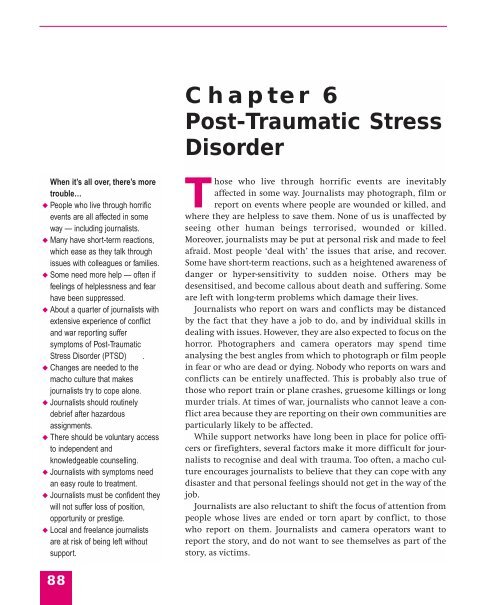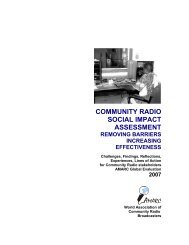Live News - A Survival Guide - International Federation of Journalists
Live News - A Survival Guide - International Federation of Journalists
Live News - A Survival Guide - International Federation of Journalists
- No tags were found...
You also want an ePaper? Increase the reach of your titles
YUMPU automatically turns print PDFs into web optimized ePapers that Google loves.
Chapter 6Post-Traumatic StressDisorderWhen it’s all over, there’s moretrouble…◆ People who live through horrificevents are all affected in someway — including journalists.◆ Many have short-term reactions,which ease as they talk throughissues with colleagues or families.◆ Some need more help — <strong>of</strong>ten iffeelings <strong>of</strong> helplessness and fearhave been suppressed.◆ About a quarter <strong>of</strong> journalists withextensive experience <strong>of</strong> conflictand war reporting suffersymptoms <strong>of</strong> Post-TraumaticStress Disorder (PTSD) .◆ Changes are needed to themacho culture that makesjournalists try to cope alone.◆ <strong>Journalists</strong> should routinelydebrief after hazardousassignments.◆ There should be voluntary accessto independent andknowledgeable counselling.◆ <strong>Journalists</strong> with symptoms needan easy route to treatment.◆ <strong>Journalists</strong> must be confident theywill not suffer loss <strong>of</strong> position,opportunity or prestige.◆ Local and freelance journalistsare at risk <strong>of</strong> being left withoutsupport.Those who live through horrific events are inevitablyaffected in some way. <strong>Journalists</strong> may photograph, film orreport on events where people are wounded or killed, andwhere they are helpless to save them. None <strong>of</strong> us is unaffected byseeing other human beings terrorised, wounded or killed.Moreover, journalists may be put at personal risk and made to feelafraid. Most people ‘deal with’ the issues that arise, and recover.Some have short-term reactions, such as a heightened awareness <strong>of</strong>danger or hyper-sensitivity to sudden noise. Others may bedesensitised, and become callous about death and suffering. Someare left with long-term problems which damage their lives.<strong>Journalists</strong> who report on wars and conflicts may be distancedby the fact that they have a job to do, and by individual skills indealing with issues. However, they are also expected to focus on thehorror. Photographers and camera operators may spend timeanalysing the best angles from which to photograph or film peoplein fear or who are dead or dying. Nobody who reports on wars andconflicts can be entirely unaffected. This is probably also true <strong>of</strong>those who report train or plane crashes, gruesome killings or longmurder trials. At times <strong>of</strong> war, journalists who cannot leave a conflictarea because they are reporting on their own communities areparticularly likely to be affected.While support networks have long been in place for police <strong>of</strong>ficersor firefighters, several factors make it more difficult for journaliststo recognise and deal with trauma. Too <strong>of</strong>ten, a macho cultureencourages journalists to believe that they can cope with anydisaster and that personal feelings should not get in the way <strong>of</strong> thejob.<strong>Journalists</strong> are also reluctant to shift the focus <strong>of</strong> attention frompeople whose lives are ended or torn apart by conflict, to thosewho report on them. <strong>Journalists</strong> and camera operators want toreport the story, and do not want to see themselves as part <strong>of</strong> thestory, as victims.88
















